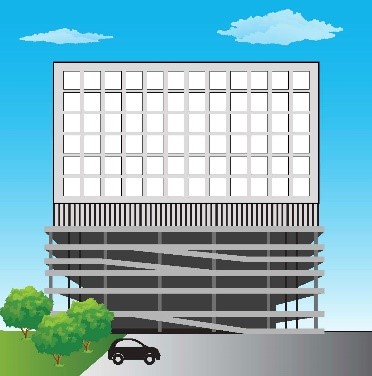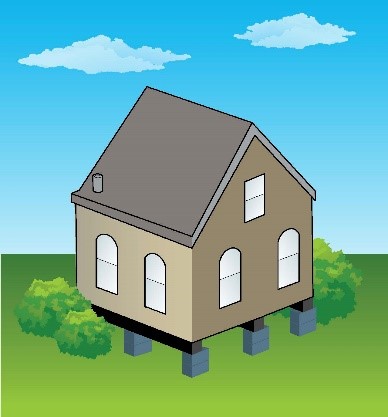
Effective passive VI mitigation can sometimes be accomplished through building design. Building design for passive VI mitigation includes the construction of vented parking garages or raised foundations between a subsurface source of vapors and an occupied space intended for living or working. Building design for VI mitigation does not include barriers (e.g., asphalt latex membrane, composite membranes, thermoplastic liners) or venting (e.g., aerated floors, sub-slab venting). This ITRC technology sheet provides basic information about relying upon building design for passive mitigation of VI and discusses advantages, limitations, and associated cost considerations of building design to mitigate VI risks. This Technology Sheet also describes the basic components of building design for the purpose of VI mitigation, design considerations, and verification of ventilation when constructing buildings designed to mitigate potential VI risks. |
General Overview
Mitigating potential VI passively through building design with certain foundation features such as a vented garage, a raised foundation, or a crawlspace (also referred to as podium construction) is not a new concept, but it is not as well-documented as other passive VI mitigation methods (e.g., vapor barriers).

(Source: J. Kasunic, used with permission.)
Vented Garages: According to international and domestic building codes, vented garages, or enclosed parking structures using enhanced building construction for natural ventilation and/or mechanical ventilation techniques associated with vehicle exhaust mitigation, as shown in Figure 1, are required to meet certain minimum air exchange rates (AERs). These are intended to limit exposure to carbon monoxide (CO), nitrogen dioxide (NO2), volatile organic compounds (VOC), and particles from the automobile exhaust within the enclosed parking garages and within occupiable spaces that are connected (both adjacent and above). When vented garages are constructed below occupied spaces that are intended for living or working, these structures may provide mitigation of VI from subsurface sources because of the high AER required by code. Demonstration of VI mitigation may be achieved by documenting continued compliance with building code requirements and that the designed AER is sufficient to reduce the potential that vapors further migrate into a structure.
This passive VI mitigation method uses natural or mechanically enhanced ventilation to mitigate potential VI risks, and it can be applied in most VI risk scenarios unless the method is determined to be unacceptable. These types of systems are most commonly used for vapor mitigation in city settings where there is a subsurface source of vapors and space is limited, making placement of a garage under the building economically feasible.
Raised Foundations/Crawlspaces: Buildings with raised foundations such as block and beam construction (Figure 2) or buildings constructed with a crawlspace (Figure 3) are more prevalent in the southern United States,

(Source: J. Kasunic, used with permission.)
where high water tables and flooding are common and/or where temperatures are mild throughout the year (i.e., no extremely cold winters). It is well documented that this type of building can effectively mitigate potential water vapor (moisture) from wet soils below buildings which, if not addressed, may result in mold growth or other structural damage to the buildings.
This passive VI mitigation method uses natural or mechanically enhanced ventilation to mitigate potential VI risks and is most applicable within: (1) geographic locations where a raised building foundation is the preferred style of foundation construction; (2) existing buildings with a raised foundation; or (3) new buildings slated for construction on top of contaminated sites where lower potential VI risks are determined to be present, especially at sites impacted with petroleum hydrocarbons.
Components
The basic components (e.g., openings, ventilation systems, foundations, vent sizes and spacing) for these types of passive VI mitigation methods are often specified in federal and state building codes.

(Source: J. Kasunic, used with permission.)
For vented garages, the following components may be a part of the system:
- Natural ventilation is provided by openings at the perimeter of the garage. Specifications for openings should include details such as uniform distribution of openings, the number of sides with openings and their orientation, the area of openings in relation to the total perimeter area, and the dimensions of the openings.
- Mechanical ventilation systems typically consist of multiple fans and air inlets typically equipped with real-time exhaust chemical monitors. Mechanically vented garages are usually sealed to increase energy efficiency.
- Fan systems draw air from the interior of the garage structure and discharge that air to the atmosphere. Makeup air is supplied via intake vents located on the exterior walls of the structure.
- Ventilation rate specifications are provided in terms of volume per square foot of the floor area.
- Mechanical ventilation often includes real-time monitoring to assess concentrations of automobile exhaust gases such as CO and/or NO2 within the garage structure. These monitoring systems can be programed to adjust ventilation rates after concentrations of exhaust gases reach threshold concentrations within the garage structure.
For raised foundations, the following components may be a part of the system:
- Block and beam and crawlspaces should be designed and constructed in accordance with applicable building codes.
- Vents for raised foundations that are naturally or mechanically vented should be designed to achieve target ventilation rates specified in applicable building codes. Usually, a target ventilation rate is twice the AER recommended by the American Society of Heating, Refrigerating, and Air-Conditioning Engineers (ASHRAE, 2013).
- For mechanically vented raised foundations, mechanical systems such as fans, wiring, and possibly automated systems that control operation of the fan system are also included.
Advantages
Designing buildings to minimize or mitigate potential VI risk has the following advantages in comparison to other technologies:
- Requirements for design, ventilation rate, and sometimes monitoring are often written into enforceable building code.
- Standards and procedures are generally familiar to, and closely followed by, construction contractors.
- Relatively low cost, particularly when implemented using natural venting.
- Code-required ventilation may provide VI mitigation without any additional capital improvements.
- Permit-required building inspections and maintenance verify compliance with code.
- Long-term post-installation performance monitoring is expected to be minimal when designed correctly and the target ventilation rate is achieved.
- Designing for VI mitigation can be combined with other technologies, if necessary.
Limitations
Designing buildings with vented garages or raised foundations to mitigate potential VI risk may have the following limitations:
- In some circumstances, buildings with raised foundations may be less preferred by developers or homebuyers compared to those with slabs or basements.
- Extra efforts (e.g., extra insulation) may be necessary to make buildings with a raised foundation as energy efficient as other types of buildings.
- Ventilation rates may need to be calculated to verify that code-required minimum ventilation rates are sufficient for VI mitigation. If insufficient, a higher ventilation rate should be to be incorporated into the ventilation system design.
- For mechanically vented garages or crawlspaces, additional effort may be needed to ensure mechanical systems function properly.
- When used for VI mitigation, a mechanical venting system may need to run continuously.
- Although field data have been collected from crawlspaces that demonstrate their effectiveness at VI mitigation, dedicated research studies on the effectiveness of mitigating VI with this method are not currently available.
- Building design may not mitigate VI risk associated with certain preferential pathways that are unable to be sealed, such as VI transport via an elevator shaft or stairwells.
Cost Considerations
Compared to active VI mitigation systems and the other passive mitigation systems, these passive mitigation systems have much lower capital expense and minimal operating expense, although the cost for constructing a building with a crawlspace or vented garage can be more expensive than that with a slab.
Designing a garage or raised foundation with enough ventilation for simultaneously controlling accumulation of automobile exhaust gases and moisture and chemical vapors intruding from the subsurface is possible if the mechanical ventilation is operated continuously. Since ventilation rates are written in building codes for vented garages, the incremental costs associated with controlling VI are limited:
- It may be necessary to demonstrate that the ventilation rate is protective for VI (e.g., mass flux calculations or AER monitoring) and maintain the ventilation rate.
- There may be an incremental additional electricity cost if a ventilation rate for VI mitigation is greater than the ventilation rate required by code.
- In some cases, routine maintenance of the mechanical ventilation system may be more frequent for VI mitigation than is required by code.
- If necessary, inspection of the openings that provide natural ventilation for VI mitigation may be more frequent than those required by code.
Special Circumstances
The following special circumstances may apply:
- Demonstration that the ventilation rate is high enough to mitigate VI based on VOC flux measurements, AER measurements, or air concentration measurements may be required.
- Installation of VOC sensors with telemetry capabilities can be used to monitor and demonstrate effectiveness, if possible and available.
- Regulators may require air phase data to demonstrate effectiveness even if long-term monitoring is not otherwise necessary.
- All routine operation, maintenance, and monitoring (OM&M) procedures for mechanical venting systems dictated in building code should be conducted and documented.
- If natural ventilation is used to mitigate VI concerns, all regular inspections should be conducted and documented to ensure that the openings are not obstructed.
- Elevator shafts and stairwells in garages may require additional design components to prevent vapor migration to upper spaces via these potential preferential pathways.
- Below-grade structures may also require waterproofing. Some waterproofing membranes can also protect against VI (see also the Passive Barriers Technology Information Sheet).
Occupant, Community, and Stakeholder Considerations
It is essential to develop and implement a site-specific community involvement plan that addresses, among other things, how to win trust and gain access to properties, communicate risk to potentially exposed individuals, and minimize the disruption of people’s lives and businesses. For more details see the ITRC Public Outreach During Vapor Intrusion Mitigation Fact Sheet.
Resources
Related Links:
- ANSI/ASHRAE (American National Standards Institute/American Society of Heating, Refrigerating and Air-Conditioning Engineers, Inc). 2013. Standard 62.1-2013. 2013 for Ventilation for Acceptable Indoor Air Quality. American Society of Heating, Refrigerating and Air-Conditioning Engineers, Inc., Atlanta, GA, U.S.
- Dickson, Bruce. 2013. Guide to Closing and Conditioning Ventilated Crawlspaces. No. DOE/GO-102013-3587. National Renewable Energy Lab. (NREL), Golden, CO. U.S.
- International Code Council. 2018. International Mechanical Code 2018 Section 404 Enclosed Parking Garages. Florence, KY, U.S.: Cengage Learning.
- MPCA, (Minnesota Pollution Control Agency). 2019. Parking Facilities and Vapor Intrusion Mitigation. Design and Operation Considerations for Parking Facilities as Vapor Intrusion Mitigation Options. c-rem3-06i. https://www.pca.state.mn.us/sites/default/files/c-rem3-06i.pdf
- MPCA (Minnesota Pollution Control Agency). 2020. Vapor Mitigation Best Management Practices. c-rem3-06. https://www.pca.state.mn.us/sites/default/files/c-rem3-06.pdf.
- Mudarri, D.H. 2010. Building Code and Indoor Air Quality. Unities States Environmental Protection Agency Office of Air and Radiation, Washing D.C., U.S.
- Osborne, Michael C., et al. 1989. Radon reduction in crawl space house. Journal of Environmental Engineering 115.3 (1989): 574-589.
- USDA (United States Department of Agriculture). 2004. Crawl Space Ventilation. Forest Products Laboratory, Madison, WI, U.S.
- USDOE (United State Department of Energy) Building Energy Codes Program. 2009. Details for Mechanically Vented Crawlspaces-Code Notes. Building Energy Codes Resource Center, Washington D.C., U.S.
For more information and useful links about VI pathways and mitigation technologies, go to http://www.itrcweb.org .

[email protected], 919-707-8279 Matthew Williams, Michigan Dept. of Environment, Great Lakes, and Energy [email protected], 517-881-8641 |
Click here to view a PDF version of this Tech Sheet.


